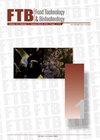如何通过控制植物营养提高刺荨麻的营养品质
IF 2.5
4区 农林科学
Q3 BIOTECHNOLOGY & APPLIED MICROBIOLOGY
引用次数: 0
摘要
研究背景。由于粮食生产面临重大挑战,现代农业实践越来越注重节约资源,减少对环境的负面影响,并可持续地生产富含促进健康的植物化学物质的食物。在生产过程中,许多因素会影响最终食品的质量和化学成分。适当选择栽培条件,特别是均衡的营养,可以显著提高营养价值,从而使食品具有较强的生物学和功能特性。荨麻是矿物质、维生素、色素、酚类和其他生物活性化合物(BC)的丰富来源,可作为绿叶蔬菜食用,对人体健康有益。因此,本研究旨在研究不同营养液处理对刺荨麻叶片营养品质和抗氧化能力的影响。实验方法。试验在浮式水培系统中进行,在三次刈割中施用不同的NS处理。每次刈割后,采取不同的处理方式:处理1 -耗水,处理2 -补充标准氮肥,处理3 -补养。用分光光度法测定BC矿物的抗坏血酸、酚类、光合色素含量及抗氧化能力,用液相色谱法测定各酚类。结果和结论。不同营养液处理和刈割次数对所分析的BC含量有显著影响。第三次割草中总酚含量最高(377.04 mg GAE/100 g fm),总黄酮含量最高(279.54 mg CTH/100 g fm),抗坏血酸含量最高(112.37 mg/100 g fm),色素含量最高(总叶绿素1.84,总类胡萝卜素0.36 mg/g),抗氧化能力最高(35.47µmol TE/g)。创新和科学贡献。这是第一次在浮动水培系统中通过控制植物营养生产荨麻叶子。我们建立了这种在多次刈割过程中的营养操纵,作为一种创新技术,用于生产具有高营养价值和改善营养价值的新型食品,适合作为绿叶蔬菜食用。本文章由计算机程序翻译,如有差异,请以英文原文为准。
How to Increase the Nutritional Quality of Stinging Nettle Through Controlled Plant Nutrition
Research background. As food production faces major challenges, modern agricultural practices are increasingly focused on conserving resources, reducing negative environmental impacts, and sustainably producing foods high in health-promoting phytochemicals. During the production process, many factors can influence the quality and chemical composition of a final food product. Proper selection of cultivating conditions, especially a balanced nutrition, can significantly increase nutritional value resulting in foods with strong biological and functional properties. Stinging nettle is a rich source of minerals, vitamins, pigments, phenols and other bioactive compounds (BC) and can be consumed as a green leafy vegetable with beneficial effects on human health. Therefore, the aim of this study was to determine the nutritional quality and antioxidant capacity of stinging nettle leaves under the influence of different nutrient solution (NS) treatments during three mowings. Experimental approach. The experiment was performed in a floating hydroponic system, with different treatments of NS application during three mowings. After each mowing, the following treatments were differed: treatment 1 – depletion with water, treatment 2 - supplementation with standard NS, and treatment 3 - correction with nutrients. Of the BC minerals, ascorbic acid, phenols, and photosynthetic pigments content, as well as antioxidant capacity were analyzed spectrophotometrically, while individual phenols were determined by liquid chromatography. Results and conclusions. Different nutrition solution treatments and the number of mowings had a significant influence on the content of the analyzed BC. The highest contents of total phenols (377.04 mg GAE/100 g fm), total flavonoids (279.54 mg CTH/100 g fm), ascorbic acid (112.37 mg/100 g fm), and pigments (total chlorophylls 1.84, and total carotenoids 0.36 mg/g), as well as the highest antioxidant capacity (35.47 µmol TE/g) were recorded in the third mowing, with nutrient solution supplementation. Novelty and scientific contribution. This is the first time that stinging nettle leaves are produced in a floating hydroponic system by controlled plant nutrition. We establish this type of nutrition manipulation during multiple mowings as an innovative technique for the production of novel food with high and improved nutritional value suitable for consumption as green leafy vegetables.
求助全文
通过发布文献求助,成功后即可免费获取论文全文。
去求助
来源期刊

Food Technology and Biotechnology
工程技术-生物工程与应用微生物
CiteScore
3.70
自引率
0.00%
发文量
33
审稿时长
12 months
期刊介绍:
Food Technology and Biotechnology (FTB) is a diamond open access, peer-reviewed international quarterly scientific journal that publishes papers covering a wide range of topics, including molecular biology, genetic engineering, biochemistry, microbiology, biochemical engineering and biotechnological processing, food science, analysis of food ingredients and final products, food processing and technology, oenology and waste treatment.
The Journal is published by the University of Zagreb, Faculty of Food Technology and Biotechnology, Croatia. It is an official journal of Croatian Society of Biotechnology and Slovenian Microbiological Society, financed by the Croatian Ministry of Science and Education, and supported by the Croatian Academy of Sciences and Arts.
 求助内容:
求助内容: 应助结果提醒方式:
应助结果提醒方式:


